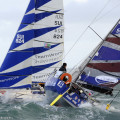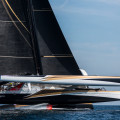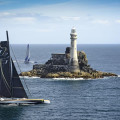Finisterre – The recurring question in Douarnenez is why did you not start on Sunday with good weather prevailing over the bay? The answer lies at Cape Finisterre on the northwestern tip of Spain. This is where the singlehanders might be caugh out in the cold, beating in winds of 35 knots in a big sea. Critical conditions for boats as small as 6.50 sailed singlehanded.
You have to imagine life on a Mini, facing the sea in bad weather. The boat becomes trapped, barely able to climb the waves at very low speeds because of its short waterline length. The cockpit is regularly swept by the waves and the skipper is tossed about, relying on his safety harness to keep him attached to the boat. Inside, it’s a real mess. Everything that can be is piled up on the windward side, everything is soaked and the boat’s movement prevent any attempt of to make a hot meal. In short, these are particularly difficult conditions for both the sailors and their machines. The rig is pounded with each wave and some masts can not stand up to the punishment.
It is understandable that in these conditions the race committee has chosen to postpone the start of the Mini Transat. Moreover, they must now find a big enough window to stop it slamming shut on the fingers of the fleet. However, the current situation offers intervals of only 48 hours, which is not sufficient to allow all competitors to cross the obstacle of the Bay of Biscay and make their descent along the western coast of Galicia. They have to sail about 450 miles before meeting more manageable conditions. To ensure the safe passage of the fleet what is needed is a weather window of about three full days. But the pressure systems currently feeding the near Atlantic are at relatively southern latitudes, making the dominant winds southerly to southwesterly. The famous jump to a nor’wester, following the passing of a depression, does not have time to establish itself before a new system takes its place.
An Asturian alternative?
Faced with such a situation, the organising team has opted to wait for favorable weather window to reach Lanzarote.
One alternative that could be considered is breaking the first leg into two separate sections. The first could take the fleet from Douarnenez to Gijon, a Spanish port that can easily accommodate a fleet of 84 Minis. Through contacts established with the Barquera during the Grand Prix Guyader the Asturian contacts of Douarnenez Courses are mobilised. At Gijon, the soloists can await another weather window to round Cape Finisterre. The advantage of the operation: by splitting the leg it considerably reduces the size of the good weather window necessary to open the road to the south. But today, no decision has yet been taken, as this solution raises a number of logistical problems. Next rendez-vous will be at 18.00 tomorrow . The race has chosen to play the card of transparency with the competitors : this is also in the spirit of the Mini.
| Vela20880 | In evidenza6126 | |
| Monotipia4165 | Oceano2722 | |
| Breaking news2564 | Altura2447 | |
| Derive2004 | English1733 | |
| America's Cup1559 | ORC-IRC1344 |





No comments so far.
Be first to leave comment below.